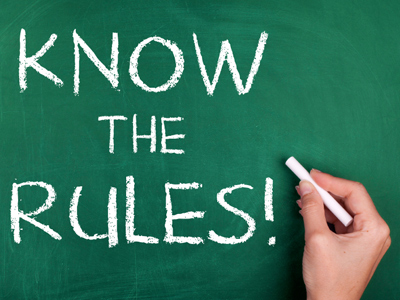Ah, we’re back to division. That should seem rather an easy math task by now and, in reality, it is. However, up until now the focus has been on your ability to understand and learn how to do the process each step of the way. That part won’t end - BUT - did you know that there are some very basic divisibility rules that can help you solve a problem even faster? Well, it’s time to let you in on these little secrets!
Although there are a number of divisibility rules, there are only 10 basic and easy rules to remember. These 10 basic rules of divisibility are as follows:
Rule 1: All numbers are evenly divisible by the number “1”. For example, the number 78 when divided by “1” equals “78”.
The number 43 when divided by the number “1” will equal “43”. The number 999 when divided by the number “1” will equal “999” and so on.
Rule 2: If a number ends with a 0, 2, 4, 6 or 8 then that number, no matter how long it is, will be evenly divisible by the number “2”. For example, look at the number 318. The last number or digit is an “8” so this tells us that the number can be evenly divided by the number “2” so let’s see if it works. 318 ÷ 2 = 159 - It worked!
Rule 3: If the combined sum of the number is divisible by the number 3, then the entire number is evenly divisible by the number “3”. For example, let’s look at the same number above, i.e., 318. Now let’s find the sum of the number so 3 + 1 + 8 = 12. The number 12 is divisible by 3 in that 12 ÷ 3 = 4. This then tells us that the number 318 is evenly divisible by the number “3” so let’s see if it works. 318 ÷ 3 = 106 - It worked!
Rule 4: If the last two digits of a number are divisible by the number “4” then the entire number is evenly divisible by the number “4”. For example, let’s look at the number 5236. The last two digits are “36” and are divisible by 4 as follows: 36 ÷ 4 = 9. Now we should be able to evenly divide the entire number by “4” so: 5236 ÷ 4 = 1309 - It worked!
Rule 5: If the last digit of a number is either a 0 or a 5, then the entire number is evenly divisible by the number “5”. For example, let’s look at the number 935. The last digit is a “5” so the number should be evenly divisible by the number “5” so 935 ÷ 5 = 187 - It worked!
Rule 6: If the last digit of a number is divisible by the number “2” and the sum of all the numbers is divisible by the number “3” then the entire number can be evenly divisible by the number “6”. Okay, let’s see how this works. Take the number 6294. The last digit is the number “4” and it is divisible by the number “2”, i.e., 4 ÷ 2 = 2, and the sum of the numbers 6 + 2 + 9 + 4 = 21 and 21 is divisible by the number “3”, i.e., 21 ÷ 3 = 7, then the entire number 6294 should be evenly divisible by the number “6” so let’s see if it is. 6294 ÷ 6 = 1049 - It worked!
Rule 7: If the sum of all of the digits is evenly divisible by the number “9” then the entire number is evenly divisible by the number “9”. For example, let’s look at the number 6687. Now we need to find the sum of the numbers so 6 + 6 + 8 + 7 = 27. The number “27” is divisible by the number “9” as 27 ÷ 9 = 3. This tells us that 6687 should be evenly divisible by the number “9” so let’s see if it works. 6687 ÷ 9 = 743 - It worked!
Rule 8: If the last digit of a number is “0” then the entire number is evenly divisible by the number “10”. For example, let’s take the number 126490. The last digit is a “0” so it should be evenly divisible by the number “10” so let’s see if it is. 126490 ÷ 10 = 12649 - It worked!
Rule 9: This one is a little tricky but if you have a number such as 4191 and, moving left to right, you subtract every second number from its preceding number and then you add the remaining numbers, if their sum is divisible by the number “11”, then the entire number is evenly divisible by the number “11”. Let’s break this down so you can see how it works. Again, the number is 4191 so we subtract every second number from the number that precedes it so: 4 - 1 = 3 and 9 - 1 = 8 then 3 + 8 = 11 and “11” is divisible by “11” as 11 ÷ 11 = 1. Now the entire number 4191 should be evenly divisible by the number “11” as 4191 ÷ 11 = 381 - It worked!
Rule 10: If the number is evenly divisible by both the numbers “3” and “4” (see Rules 3 and 4 to work this out), then the entire number will be evenly divisible by the number “12”. For example, let’s look at the number 5136. Rule 3 tells us that if the combined sum of the numbers is divisible by the number “3” then the entire number is evenly divisible by the number “3” so that gives us 5 + 1 + 3 + 6 = 15. The number 15 is divisible by the number “3” as 15 ÷ 3 = 5. Now Rule 4 tells us that if the last two digits of the number are a multiple of the number “4” then the entire number is evenly divisible by the number “4”. The last two digits are 36 and we know that 36 ÷ 4 = 9. Since our number 5136 can evenly be divisible by the numbers “3” and “4” then is should be evenly divisible by the number “12” so let’s check that out. 5136 ÷ 12 = 428 - It worked!








